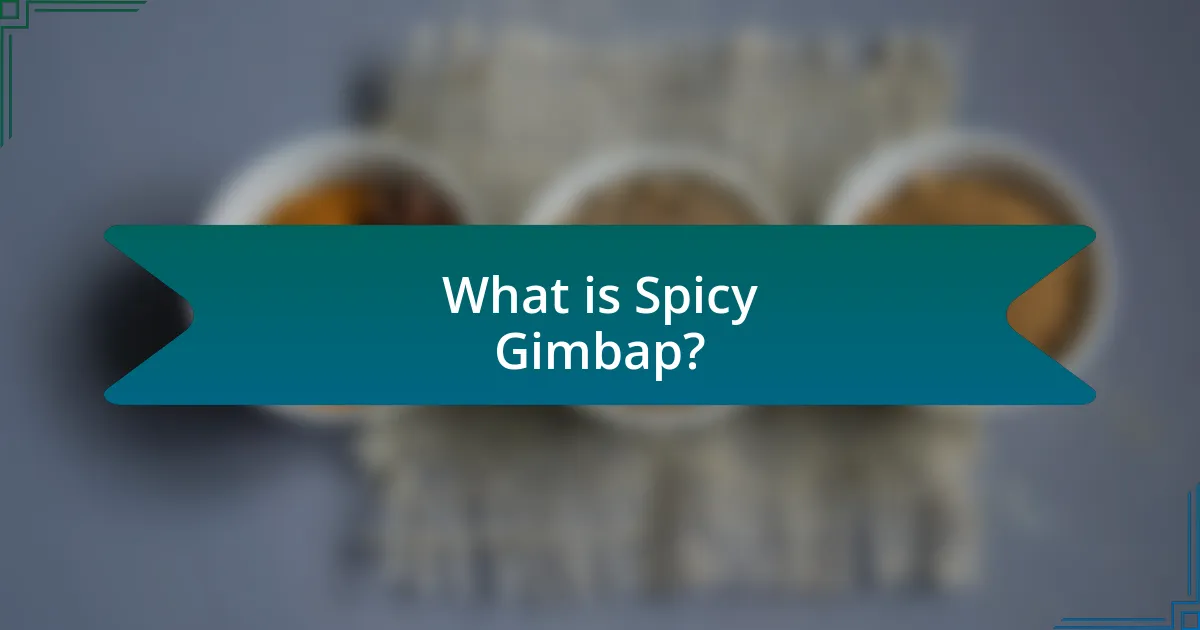Spicy Gimbap is a Korean dish that features rice and various fillings rolled in seaweed, distinguished by the inclusion of spicy ingredients such as gochujang and spicy pickled vegetables. This article explores the differences between Spicy Gimbap and traditional Gimbap, highlighting unique flavors, preparation methods, and cultural origins. It also discusses key ingredients, including vegetables and proteins, as well as popular variations and tips for making Spicy Gimbap at home. The evolution of this dish within Korean cuisine and its role in food culture are also examined, providing a comprehensive overview of Spicy Gimbap’s significance and appeal.

What is Spicy Gimbap?
Spicy Gimbap is a Korean dish consisting of rice and various fillings rolled in seaweed, with the addition of spicy ingredients such as gochujang (Korean chili paste) or spicy pickled vegetables. This variation of traditional gimbap incorporates heat and flavor, making it distinct from the standard version, which typically features milder ingredients. The use of gochujang not only enhances the taste but also reflects the Korean culinary preference for spicy flavors, as evidenced by its widespread use in various dishes across the country.
How is Spicy Gimbap different from traditional Gimbap?
Spicy Gimbap differs from traditional Gimbap primarily in its use of spicy ingredients, particularly gochujang, a Korean chili paste. While traditional Gimbap typically features a variety of fillings such as vegetables, eggs, and protein without heat, Spicy Gimbap incorporates these elements along with the addition of gochujang or other spicy components, resulting in a distinct flavor profile that emphasizes heat. This variation caters to those who prefer a spicier taste, making it a popular choice among fans of Korean cuisine.
What unique flavors are introduced in Spicy Gimbap?
Spicy Gimbap introduces unique flavors primarily through the incorporation of gochujang, a Korean chili paste, which adds a distinct heat and depth. Additionally, the use of sesame oil enhances the nutty aroma, while ingredients like pickled radish and cucumber contribute a refreshing crunch and tanginess. These elements combine to create a balanced flavor profile that distinguishes Spicy Gimbap from traditional versions.
How does the preparation method vary for Spicy Gimbap?
The preparation method for Spicy Gimbap differs primarily in the inclusion of spicy ingredients, such as gochujang (Korean chili paste) or spicy pickled vegetables, which are mixed into the rice or used as fillings. This variation enhances the flavor profile compared to traditional Gimbap, which typically features milder ingredients. Additionally, the assembly process may involve layering these spicy components alongside standard fillings like vegetables and protein, ensuring a balanced distribution of heat throughout the roll.
What are the cultural origins of Spicy Gimbap?
Spicy Gimbap originates from Korea, where it is a popular variation of traditional Gimbap. The dish reflects Korea’s culinary culture, which emphasizes fresh ingredients and bold flavors. Spicy Gimbap typically includes ingredients like gochujang (Korean chili paste), which adds heat and depth, showcasing the Korean preference for spicy foods. The dish has evolved from its roots, influenced by the availability of ingredients and regional tastes, making it a staple in Korean cuisine.
How has Spicy Gimbap evolved over time in Korean cuisine?
Spicy Gimbap has evolved significantly in Korean cuisine, transitioning from a traditional dish primarily filled with vegetables and protein to a modern variation that incorporates diverse ingredients and flavors, including spicy sauces and meats. Originally, Gimbap was a simple meal for farmers and laborers, made with rice, vegetables, and sometimes fish or beef, wrapped in seaweed. Over time, particularly in the late 20th century, the introduction of gochujang (Korean chili paste) and other spicy elements transformed Gimbap into a more flavorful and vibrant dish, appealing to a broader audience. This evolution reflects changing tastes and the influence of globalization, as various ingredients from different cultures have been integrated into the traditional recipe, making Spicy Gimbap a popular choice in both local and international cuisine.
What role does Spicy Gimbap play in Korean food culture?
Spicy Gimbap serves as a popular and culturally significant dish in Korean food culture, often enjoyed as a convenient meal or snack. This variation of traditional gimbap incorporates spicy ingredients, reflecting the Korean preference for bold flavors. Spicy Gimbap is commonly found in street food markets and is a staple in picnics and lunchboxes, showcasing its versatility and accessibility. The dish not only highlights the importance of rice and vegetables in Korean cuisine but also emphasizes communal eating, as it is often shared among friends and family.

What are the key ingredients in Spicy Gimbap?
The key ingredients in Spicy Gimbap include rice, seaweed, pickled radish, cucumber, carrots, and a spicy sauce, often made with gochujang (Korean red chili paste). Rice serves as the base, while seaweed wraps the fillings. Pickled radish adds a tangy flavor, and cucumber and carrots provide crunch and freshness. The spicy sauce enhances the overall taste, making Spicy Gimbap distinct from traditional Gimbap.
Which vegetables are commonly used in Spicy Gimbap?
Spicy Gimbap commonly includes vegetables such as cucumber, pickled radish, carrot, and spinach. These vegetables provide a balance of flavors and textures, enhancing the overall taste of the dish. Cucumber adds crunch, pickled radish contributes a tangy flavor, carrot offers sweetness, and spinach provides a nutritious green element.
How do different vegetables contribute to the flavor profile?
Different vegetables contribute to the flavor profile of gimbap by providing distinct tastes, textures, and aromas that enhance the overall dish. For instance, pickled radish adds a tangy crunch, while spinach offers a mild earthiness. Carrots introduce sweetness and color, and cucumber contributes a refreshing crispness. Each vegetable’s unique flavor compounds, such as the umami from mushrooms or the bitterness from perilla leaves, interact to create a balanced and complex taste experience. This combination of flavors is essential in traditional gimbap, where the interplay of ingredients is crucial for achieving the desired culinary harmony.
What are the best practices for preparing these vegetables?
The best practices for preparing vegetables for Korean spicy gimbap include washing, peeling, and cutting them into uniform sizes to ensure even cooking and presentation. Washing removes dirt and pesticides, while peeling can enhance texture and flavor, particularly for vegetables like cucumbers and carrots. Cutting vegetables into thin, consistent strips allows for easier rolling and a balanced taste in each bite. For example, carrots should be julienned to a size that complements the other ingredients, ensuring they cook evenly and maintain a crisp texture. These practices enhance the overall quality and enjoyment of the gimbap.
What proteins can be included in Spicy Gimbap?
Spicy Gimbap can include proteins such as beef, tuna, crab meat, and eggs. These proteins are commonly used to enhance the flavor and nutritional value of the dish. For instance, marinated beef adds a savory taste, while canned tuna provides a convenient and popular option. Crab meat, often used in imitation form, contributes a seafood flavor, and eggs can be scrambled or used as a thin omelet to add richness. Each of these proteins complements the spicy and tangy elements of Gimbap, making it a versatile dish.
How does the choice of protein affect the overall taste?
The choice of protein significantly influences the overall taste of gimbap. Different proteins, such as beef, chicken, or tofu, impart distinct flavors and textures, enhancing the dish’s complexity. For instance, beef provides a rich, savory taste, while chicken offers a milder flavor, and tofu contributes a subtle earthiness. The specific preparation methods, such as marinating or seasoning, further amplify these flavors, making the protein choice crucial for achieving the desired taste profile in gimbap.
What are some vegetarian alternatives for Spicy Gimbap?
Vegetarian alternatives for Spicy Gimbap include ingredients such as pickled radish, cucumber, carrots, spinach, and tofu. These ingredients can be seasoned with gochujang (Korean chili paste) for spice and flavor, maintaining the essence of traditional gimbap while ensuring it is meat-free. The use of these vegetables and tofu not only provides a variety of textures but also aligns with the nutritional profile typically sought in gimbap, making it a satisfying vegetarian option.
What condiments and seasonings enhance Spicy Gimbap?
Spicy Gimbap is enhanced by condiments and seasonings such as gochujang (Korean red chili paste), sesame oil, and pickled radish. Gochujang adds a rich, spicy flavor that complements the rice and fillings, while sesame oil contributes a nutty aroma and taste. Pickled radish, known as danmuji, provides a tangy crunch that balances the spiciness. These ingredients are commonly used in traditional recipes, reinforcing their importance in achieving the authentic flavor profile of Spicy Gimbap.
How does gochujang influence the spiciness of Gimbap?
Gochujang significantly enhances the spiciness of Gimbap by providing a rich, fermented chili flavor that is both spicy and slightly sweet. This Korean red chili paste contains gochugaru (Korean red pepper flakes), which contributes to its heat level, making Gimbap more flavorful and piquant. The fermentation process of gochujang also adds depth to the overall taste profile, balancing the spiciness with umami notes, which complements the other ingredients in Gimbap.
What other seasonings can be used to customize the flavor?
Various seasonings can be used to customize the flavor of gimbap, including sesame oil, soy sauce, gochujang, and garlic powder. Sesame oil adds a nutty richness, while soy sauce contributes umami depth. Gochujang introduces a spicy and slightly sweet element, and garlic powder enhances the overall flavor profile. These seasonings are commonly used in Korean cuisine to elevate dishes, making them versatile options for gimbap customization.

How can you make Spicy Gimbap at home?
To make Spicy Gimbap at home, prepare cooked rice mixed with sesame oil, salt, and gochugaru (Korean red pepper flakes) for spice. Lay a sheet of seaweed (nori) on a bamboo mat, spread the rice evenly, and add fillings such as pickled radish, cucumber, carrots, and spicy tuna or marinated vegetables. Roll tightly, slice into bite-sized pieces, and serve with soy sauce or additional gochujang for dipping. This method is based on traditional Korean recipes that emphasize the balance of flavors and textures in Gimbap.
What are the essential steps in preparing Spicy Gimbap?
To prepare Spicy Gimbap, first, cook and season the rice with vinegar, sugar, and salt. Next, prepare the filling by sautéing vegetables such as carrots, spinach, and pickled radish, along with protein options like spicy tuna or beef. Then, lay a sheet of seaweed on a bamboo mat, spread the seasoned rice evenly, and add the filling in a line. Roll the mat tightly to form a cylinder, then slice the roll into bite-sized pieces. This method ensures the gimbap is flavorful and visually appealing, as traditional Korean recipes emphasize both taste and presentation.
How do you properly cook and season the rice for Gimbap?
To properly cook and season the rice for Gimbap, first, rinse 2 cups of short-grain rice under cold water until the water runs clear to remove excess starch. Then, cook the rice in a rice cooker or on the stovetop with 2.5 cups of water, allowing it to steam for about 20 minutes until tender. After cooking, transfer the rice to a large bowl and let it cool slightly. For seasoning, mix 2 tablespoons of rice vinegar, 1 tablespoon of sugar, and 1 teaspoon of salt into the warm rice, gently folding to combine without mashing the grains. This method ensures the rice is sticky and flavorful, essential for rolling Gimbap.
What techniques are used for rolling Gimbap effectively?
To roll Gimbap effectively, one should use the technique of layering ingredients evenly on the rice and employing a bamboo mat for rolling. This method ensures that the rice and fillings are distributed uniformly, which prevents the Gimbap from falling apart. Additionally, applying gentle but firm pressure while rolling helps to create a tight roll, enhancing the overall structure and presentation of the Gimbap. Using a sharp knife to slice the rolled Gimbap into even pieces further maintains the integrity of the roll and showcases the colorful ingredients inside.
What are some popular variations of Spicy Gimbap?
Popular variations of Spicy Gimbap include Tuna Gimbap, which incorporates spicy tuna mixed with mayonnaise, and Kimchi Gimbap, featuring fermented kimchi for added heat. Another variation is Spicy Pork Gimbap, where marinated spicy pork is used as a filling. These variations enhance the traditional gimbap by introducing different spicy elements, appealing to diverse palates. The use of ingredients like spicy gochujang or seasoned vegetables further distinguishes these types, making them favorites among gimbap enthusiasts.
How do regional differences influence Gimbap recipes?
Regional differences significantly influence Gimbap recipes by altering the choice of ingredients and preparation methods based on local tastes and available resources. For instance, in coastal regions, seafood such as tuna or crab is commonly included, while inland areas may favor beef or pickled vegetables. Additionally, specific regions may incorporate unique local ingredients, such as perilla leaves in Jeolla Province or spicy gochujang in Gyeonggi Province, reflecting the culinary traditions and agricultural products of those areas. This diversity in ingredients not only enhances the flavor profiles but also showcases the cultural identity of each region within Korea.
What creative twists can be added to traditional recipes?
Creative twists that can be added to traditional recipes include incorporating unique ingredients, such as using quinoa instead of rice in gimbap for added nutrition and texture. Additionally, experimenting with flavors by adding spicy sauces or pickled vegetables can enhance the taste profile. For instance, integrating kimchi into the filling not only adds spice but also introduces probiotics, making the dish healthier. Furthermore, using alternative proteins like tofu or tempeh can cater to vegetarian diets while maintaining the essence of the original recipe. These modifications not only modernize traditional dishes but also appeal to diverse dietary preferences.
What tips can help improve your Spicy Gimbap-making skills?
To improve your Spicy Gimbap-making skills, focus on mastering the rice preparation and ingredient balance. Properly cooked short-grain rice, seasoned with vinegar, sugar, and salt, creates the ideal texture and flavor for gimbap. Additionally, ensure that the vegetables and proteins are cut uniformly to promote even rolling and presentation. Using a bamboo mat for rolling helps achieve a tight and consistent shape, which is crucial for the final appearance. Finally, practice rolling techniques, applying even pressure while rolling to avoid tearing the seaweed. These methods enhance both the taste and visual appeal of your Spicy Gimbap.
How can you ensure the rice has the right texture?
To ensure the rice has the right texture for gimbap, use short-grain rice and rinse it thoroughly before cooking. Short-grain rice contains more starch, which helps achieve a sticky texture ideal for gimbap. Rinsing removes excess starch, preventing the rice from becoming overly gummy. Cook the rice with a water-to-rice ratio of about 1.1:1, allowing it to absorb the right amount of moisture. After cooking, let the rice rest for about 10-15 minutes to firm up, which enhances its texture for rolling.
What common mistakes should be avoided when making Gimbap?
Common mistakes to avoid when making Gimbap include using the wrong type of rice, overfilling the rolls, and not properly seasoning the ingredients. Using short-grain rice, specifically Korean sticky rice, is essential for achieving the right texture; long-grain rice can lead to a dry and crumbly roll. Overfilling can cause the Gimbap to burst during rolling, making it difficult to slice and eat. Additionally, neglecting to season the vegetables and proteins can result in bland flavors, which diminishes the overall taste of the dish.


